The ZSU-23-4 "Shilka" is a lightly armored Soviet self-propelled, radar-guided anti-aircraft weapon system (SPAAG). Still in service despite its partial replacement by the 2K22 Tunguska (1982). Widely exported, it remained today the most available SPAAG worlwide, seeing combat around the world from 1966 to this day in Ukraine.
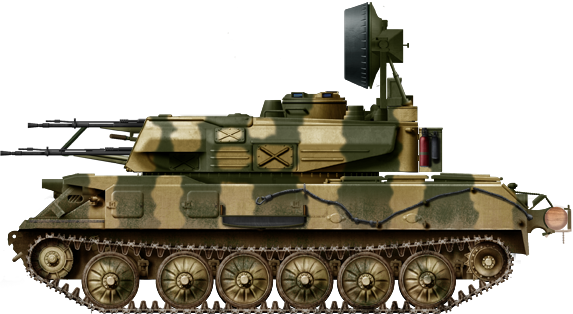
In between, the USSR developed a range of more modern systems, usually smaller, on tripods or wheeled mounts, but not motorized. For example the quad ZPU 14.5 mm heavy machine gun (towed mount) was often preferred for point air defence thanks to its much higher rate of fire. It was especially appreciated against helicopters and low-flying aircraft. The 14.5 mm was further developed into a 23 mm gun using th same mecanisms to keep the rate of fire, and this became the ZU-23-2 towed mount. But both systems did not offered much in terms of accuracy, lackong a radar and automated tracking. Plus they needed time to be deployed.
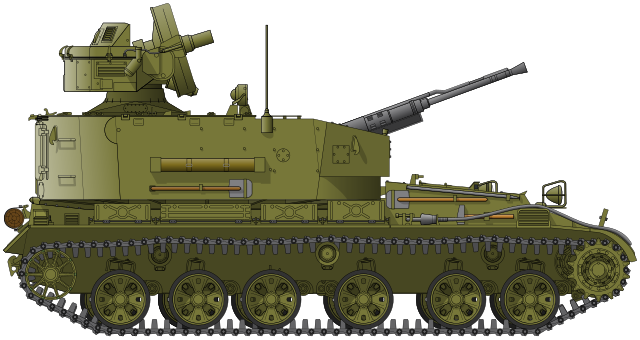
ZSU-37-2 Yenisei, unhappy competitor.
Thus, the Army wanted a new self-propelled system based around the new ZU-23-2, but ideally with twice the firepower, and all what was lacking to defend the Soviet Armoured push to the west. Development of the ZSU-23-4 "Shilka" started in 1957 already, almost at the same time as the ZSU-37-2 "Yenisei". The latter remained an experimental self-propelled anti-aircraft gun fitted with a twin 37 mm autocannon with a rate of fire of 1048 rounds per minute. But trials were not encouraging and the project was stopped in 1962, never authorized for production.
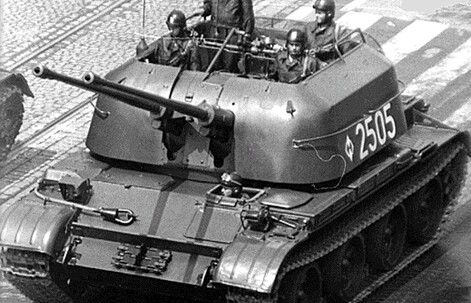
The system to be replaced, ZSU-57-2 "sparka"
Meanwhile development of the parralel 23-4 system proceeded in 1959-62, followed by intensive trialsand many corrections. It was only authorized by 1965, and started to replace all ZSU-57-2s in active units, and by 1976, the "Sparka" has been completely retired and exported. The ZSU-23-4 was planned to bring point defense of military facilities but also moving defence of troops and mechanized columns. The "Yenisei" 37 mm were judged effective to cover the inner dead-zone of Soviet SAM systems despite of the time, but commonality prevailed as the 23 mm was becoming the new standard.
The first reveal of the "Shilka" caused turmoil in NATO circles as tactics developed against tanks concentrations had to be scrapped overnight. Low altitude combat had to be adapted and helicopters needed some protection from these vehicles over the battlefield. As of today, and despite is obsolescence, the ZSU-23-4 is still an excellent battlefield vehicle, as infantry support. It could destroy quickly any enemy light armoured vehicles, rampage through softskin targets, mow down infantry. It os simply one of the best infantry-support vehicle, with the limitation of weak armour protection. This is compensated by a high rate of accurate fire. On paper it was shown able to destroy gun sights of tanks, as their radio antennas or other weak points. The thermal blast of the incoming rounds is also enough to blind any approaching tank. The ZSU-23-4s were also regularly upgraded to this day in many counties to stay relevant until the 2030s...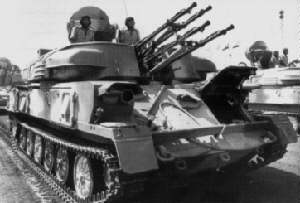 The radar-guided ZSU-23-4 "Shilka" SPAAG is clearly a setup from the primitive "Sparka" thanks to its radar and high fire rate. The four 23 mm (0.90") autocannons were proven very extremely effective against enemy slow/low attack aircraft and helicopters and unlike the previous 57-2, under every weather and light condition. It is more accurate and offered the luxury of having all four autocannons ammo-fed independently with a large variety of projectiles, from separate belts.
The radar-guided ZSU-23-4 "Shilka" SPAAG is clearly a setup from the primitive "Sparka" thanks to its radar and high fire rate. The four 23 mm (0.90") autocannons were proven very extremely effective against enemy slow/low attack aircraft and helicopters and unlike the previous 57-2, under every weather and light condition. It is more accurate and offered the luxury of having all four autocannons ammo-fed independently with a large variety of projectiles, from separate belts.
Inside the vehicle are located the driver (forward hull) the commander, gunner and radar operator taking seats in the turret. The driver's compartment n the nose is topped by a main day sight with swappable IR sight, and he had a build-in nose hatch/window for regular driving. The center fighting compartment houses the three other crew members, and the engine compartment is located at the rear with the drive spockets and transmission. This usual repartition helps the vehicle to stay low.
Output: 280 hp (209 kW) at 2,000 rpm
Power/weight: 14.7 hp/tonne (11.0 kW/tonne)
Maximum speed: 50 km/h (31 mph) road, 30 km/h (19 mph) off-road
Ranage, based on a 515 Liter tank capacity, 450 km (road), 300 km (off-road)
The transmission counts a multi-plate metal-contact main clutch, manual gearbox (five forward speeds), and two planetary two-step steering gears (with locking friction), plus two final drive groups. In addition, there was an auxiliary power unit (APU) to feed the onboard systems, including the armament, when the main engine was cold. It was assured by a DGChM-1 single-shaft gas turbine engine (70 hp at 6,000 rpm) providing thougha direct-current generator (27 V and 54 V or 220 V 400 Hz alternating). Thus also fed the navigation system, IR sight, R-123 radio set, and R-124 intercom.
For suspensions, the vehicle counts six single rubber tired road wheels per side, plus rear drive sprockets (with detachable sprocket rings, and lantern-wheel gear) and front idler wheels. The Ground clearance is of 375 mm (14.8 in). They had all individual torsion bars however the first and fifth, sixth road wheels have hydraulic shock absorbers in asymetric positions (5th left, 6th right side). The track measure 11.904 m () long, for 382 mm (15 inches) wide with 93 links but no rubber pads.
The ZSU-23-4 was found able to climb vertical obstacles of 0.7 m (2.3') or climb 30° gradients, and gap a 2.5 m (8.2') wide trench, or ford without preparation up to 1.0 m (3.3') of water. It is not amphibious. In general despite its low speed, it had good maneuverability, handling and cross-country ability. For orientation, the vehicle was given a TNA-2 navigational system.
 Ammunition capacity is 2,000 rounds stowed aboard, 520 per top autocannon, 480 rounds for lower autocannons. They are provided into 50-round belts usually. These are 23×152B mm caliber ammunition, same as the 2A14 guns (ZU-23-2 towed mount). They are derived from the Sturmovik-famed WW2 23mm Volkov-Yartsev VYa-23 aircraft gun ammunitions but differed in loading and primer and not interchangeable, having slightly higher muzzle velocity and explosive rounds with larger HE fillings plus steel cases.
Ammunition capacity is 2,000 rounds stowed aboard, 520 per top autocannon, 480 rounds for lower autocannons. They are provided into 50-round belts usually. These are 23×152B mm caliber ammunition, same as the 2A14 guns (ZU-23-2 towed mount). They are derived from the Sturmovik-famed WW2 23mm Volkov-Yartsev VYa-23 aircraft gun ammunitions but differed in loading and primer and not interchangeable, having slightly higher muzzle velocity and explosive rounds with larger HE fillings plus steel cases.
These were commonly the OFZT incendiary fragmentation and BZT armour-piercing tracer in a 3:1 ratio and the later were interleaved by marked "copper remover" rounds, every tenth. However depending on the missiones, API-T, HEI and HEI-T would be procured.
-The BZT API is capable of 970 mps and had a Blunt AP steel core with incendiary charge, defeats up to 15 mm RHA at 1000 m, 30°. -The OFZ HE is a 980 mps fragmentation round with nose fuzes. -The OFZT HE-T is a 980 fragmentation round with reduced HE charge but filled with tracer. -The APDS-T is a Polish developed proper ground combat round capable of 1220 mps, defeating 30 mm RHA at 100 m range, 30°.
Typical range, horizontal, is of 7 km (4.3 mi) and vertical 5.1 km (3.2 mi). Cailing ranges from 1.5 km (0.93 mi) to 2.5 km (1.6 mi) at a tracking speed of 250 m/s and up to 500 m/s after upgrades. Standards burst fired when setup are 3–10 projectiles with the lead angle calculated for each without adjustment by computer. Against ground targets, 2.5 km (1.6 mi) is effective. The vehicle was far less capable against jet attack aircraft and cruise missiles than the 2K22 Tunguska although a special 23 mm round with composite projectiles was developed later for the ZSU-23-4M4 to fire on cruise missiles as a CIWS.
*3.572 m (11 ft 8.6 in) with radar elevated
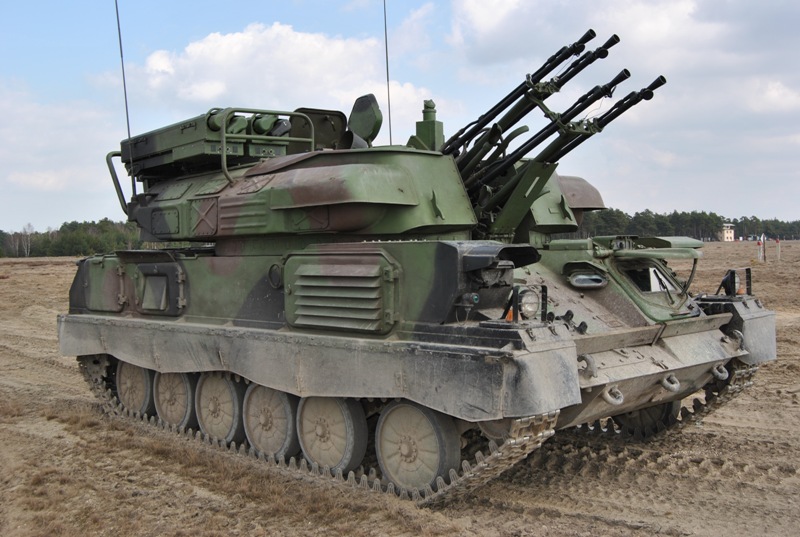
Polish ZSU-23-4MP BIALA
The ZSU-23-4MP "Biała" (polish "White" and small Polish river) is a modernized Polish upgrade with the following innovations:
-4 Grom surface-to-air missiles 5.5 km range
-Fully digital passive aiming devices
-New digital optical targeting system
-Modern ammunitions
-Anti-aircraft range 3.5 km
Around 70 ZSU-23-4MP "Biała" self-propelled anti-aircraft guns were chosen to be upgrade over the Polish 35 mm PZA Loara which was found much costier.
-2x2 "Igla" MANPADS on either side of the turret (remote controlled)
-New 81mm smoke grenade launchers
-Laser emission sensors
-Electro-optical vision devices
-Television for the driver
-Improved weapon radar system
-Hydrostatic transmission with hydraulic boosters.
This upgrade was unveiled at the MAKS-99 exhibition in Zhukovsky by the Minotor Service Enterprise, associated with Peleng of Belarus, and Ulyanovsk Mechanical Plant, also offering ZSU-23-4 upgrade packages.
-Advanced 3D active phased array radar
-New computers suite
-New electro-optical fire control systems
-New Caterpillar 359 BHP diesel engine
-New APU.
The upgraded kit allows operation despite intensive, with a detection/treatment range of 15 km away and thermal protection ranging from +55° to -40° Celsius. The computers helps shooting down a 450 mph target from 1,500 metres to 2,500 metres. This upgrade was approved in December 2004 in order to porlongate the active life of the 48 Indian SPAAGs by 15 years, based on a US$104 million contract.
-ASADS Ka-band target tracking radar
-PAGE I-band surveillance radar.
New digital and optoelectronics systems, four Igla SAMs, new domestic digital fire-control system with a thermal camera, daylight camera, laser rangefinder.
Afghanistan: 20 delivered from USSR in the late 1970s
Algeria: 210 in 1995, perhaps 310 delivered from USSR.
Angola: 20 delivered from USSR in the late 1970s, saw action with SADF
Armenia (unknown)
Azerbaijan (unknown)
Cameroon: 200 ordered from Russia in the 1990s (surplus) 128 delivered, new contract in 2011 for 300–350.
Congo-Brazzaville: 8
Cuba: 36 in 1995 from Russia
Egypt: 350 in 1970. Took part in the 1973 war. 330 more delivered in 2005.
Ecuador: 34 (ex-Nicaragua) in 1997.
Eritrea: Captuured from Ethiopia, number unknown
East Germany 131 delivered from USSR, passed on to Germany after the reunification and decommissioned.
Ethiopia: 60
Guinea-Bissau: 16 by USSR.
India: 100 delivered from USSR.
Iran: 100+
Iraq: 200+
ISIL: Small numbers captured from Syrian army.
Israel: 60 captured from Arab armies in 1973, used for Air Defence.
Jordan: 16 in 1995 from USSR), but 45 by 2008.
Kyrgyzstan: 24 in 2022.
Laos: 10+
Libya: 250
Lebanon: ex-PLO, Al-Mourabitoun, Amal Movement
Mali: 3-4 in 2013.
Mongolia: Unknown numbers
Moldova:, unknown, Retired by 2022.
Nicaragua: Sold to Ecuador.
Nigeria: 30
Palestine (PLO) 8 delivered from USSR/Hungary, passed on to local militias.
Poland: 28 in 2015, 150 until 1991. Modernization to the ZSU-23-4MP Biała standard.
Russia: ~133 in active service, 2011, Marines. 60 used by the Naval Infantry by 2022.
Sahrawi Arab Democratic Republic (unknown number)
Somalia: 4, Ogaden War, now retired.
South Yemen: Unknown
Syria: 400 delivered from USSR.
Kurdish People's Defense Units (YPG), unknown.
Turkmenistan: 28 in 2016, 48 in 2022.
Ukraine (unknown)
Vietnam: 100
Yemen: 30-40 1995, delivered to South Yemen from USSR.
The ZSU-23-4 proved however easy meat for anti-tank missiles or tank guns and even heavy machine guns when not presenting the front. The wheels, tracks, radar and gun barrels were all unprotected. So these vehicles were usuall placed near the forward edge of the battle area and behind the main forces, 600–1000 m behind in defense or or 400–600 m behind the leading tanks in offensive. The vehicles were deployed autonomously, but by 1978, they began to be controlled by the PPRU-1 ("Ovod-M-SV" or mobile reconnaissance and control post) variant of the MT-LBu tasked fof coordinating AA defense of motor rifle or tank regiments, and supervising both ZSU-23-4 and 9K31 mobile units. The PPRU-1 used the longer range "Luk-23" radar for better coverage and could pass data to its subordonated units, also working with the divisional air defence system.
It was widely adopted throughout the Warsaw Pact, pro-Soviet states and all countries that needed that system, and so of about 6,500 produced, 2,500 were exported to 23 countries. Successor states continued to manufacture and supply variants, notably the Ukrainian "Donets" and Polish "Biala" already seen above.
The ZSU-23-4 during its long career saw plenty of combat use: Yom Kippur War (1973) and Arab-Israeli conflicts in general, the Iran–Iraq War (1980–1988), First Gulf War (1990). In 1973 these vehicle crippled the Israeli Air Force, as pilots flew low to avoid SA-6 missiles. This happened in particular during Operation Doogman 5. The Soviet–Afghan War saw these vehicles very effective against mujahideen mountain positions due to their elevation greater than any other convetional vehicles. So much so that they were later tailored for the job and became pure ground support vehicles. For example they "cleaned up" the presidential palace defence during the coup in Kabul, starting the war. The "Afghan Variants" proved their effectiveness more recently when deployed in mountain combat in Chechnya.
ZSU-23-4s were found relatively useful in urban environments, fighting that way in Afghanistan, Abkhazia, Chechnya, Syria and Lebanon, being fast to answer in ambushes from above. In Russian service today, the vehicle has been sidelines, but is still used by Russian Naval Infantry, notably the 61st Brigade of the Northern Fleet, 336th Brigade of the Baltic Fleet, 155th Brigade of the Pacific Fleet, still not equipped with the Tunguska. They are likely of the latest M4 upgrade.
The Shilka was also used in the 2014 Russo-Ukrainian War and from the 2022 Russian Invasion, also by both forces. On this chapter, so far according to Oryx, eight Russian were lost, captured or destroyed
Perrett, Bryan (1987). Soviet Armour Since 1945. London: Blandford Press.
Shirokorad, A. (February 1998). Bronekollektsiya: "Shilka" i drugie otechestvennye ZSU ("Shilka" and Other Native SPAAGs). Issue of a Russian journal.
Bassel Abi-Chahine, The People's Liberation Army through the eyes of a lens, 1975–1991, Éditions Dergham, Jdeideh (Beirut) 2019.
Samer Kassis, Invasion of Lebanon 1982, Abteilung 502, 2019.
Mike Guardia and Henry Morshead, Self-Propelled Anti-Aircraft Guns of the Soviet Union, New Vanguard series 222, Osprey Publishing Ltd, Oxford 2015.
Zaloga, Steve [Steven J.] (1993). ZSU-23-4 Shilka & Soviet Air Defense Gun Vehicles. Hong Kong: Concord Publications. ISBN 962-361-039-4.
Zachary Sex & Bassel Abi-Chahine, Modern Conflicts 2 – The Lebanese Civil War, From 1975 to 1991 and Beyond, Modern Conflicts Profile Guide Volume II, AK Interactive, 2021.
armyinrussian.narod.ru
pvo.guns.ru
otvaga2004.narod.ru
gulflink.osd.mil
weaponsystems.net
svppbellum.blogspot.com
armedconflicts.com
On Wikipedia
track-link.com
Design Development
The acronym "ZSU" used for all Soviet SPAAGs stands for "Zenitnaya Samokhodnaya Ustanovka" or "anti-aircraft self-propelled system". The following numbers meant the bore diametre (millimetric) and barrels numbers. As usual a sort of semi-informal nickname was attached to it, which became popular, and this was "Shilka" after a River in Russia. The birth of the vehicle is linked to the ZSU-57-2 "sparka" (twin 57 mm autocannons), an older generation vehicle for the same purpose, but which was aimed optically using basic tracking, lead calculations. It was already too slow for jest, and not particularly successful. Its only interest lied into its very powerful autocannons, marred by a limited 300 round supply, still appreciated in a ground role. However in its AA defensive role it was too slow and inaccurate, lacking radar and unstabilized (it could not fire on the move).
In between, the USSR developed a range of more modern systems, usually smaller, on tripods or wheeled mounts, but not motorized. For example the quad ZPU 14.5 mm heavy machine gun (towed mount) was often preferred for point air defence thanks to its much higher rate of fire. It was especially appreciated against helicopters and low-flying aircraft. The 14.5 mm was further developed into a 23 mm gun using th same mecanisms to keep the rate of fire, and this became the ZU-23-2 towed mount. But both systems did not offered much in terms of accuracy, lackong a radar and automated tracking. Plus they needed time to be deployed.

ZSU-37-2 Yenisei, unhappy competitor.
Thus, the Army wanted a new self-propelled system based around the new ZU-23-2, but ideally with twice the firepower, and all what was lacking to defend the Soviet Armoured push to the west. Development of the ZSU-23-4 "Shilka" started in 1957 already, almost at the same time as the ZSU-37-2 "Yenisei". The latter remained an experimental self-propelled anti-aircraft gun fitted with a twin 37 mm autocannon with a rate of fire of 1048 rounds per minute. But trials were not encouraging and the project was stopped in 1962, never authorized for production.

The system to be replaced, ZSU-57-2 "sparka"
Meanwhile development of the parralel 23-4 system proceeded in 1959-62, followed by intensive trialsand many corrections. It was only authorized by 1965, and started to replace all ZSU-57-2s in active units, and by 1976, the "Sparka" has been completely retired and exported. The ZSU-23-4 was planned to bring point defense of military facilities but also moving defence of troops and mechanized columns. The "Yenisei" 37 mm were judged effective to cover the inner dead-zone of Soviet SAM systems despite of the time, but commonality prevailed as the 23 mm was becoming the new standard.
The first reveal of the "Shilka" caused turmoil in NATO circles as tactics developed against tanks concentrations had to be scrapped overnight. Low altitude combat had to be adapted and helicopters needed some protection from these vehicles over the battlefield. As of today, and despite is obsolescence, the ZSU-23-4 is still an excellent battlefield vehicle, as infantry support. It could destroy quickly any enemy light armoured vehicles, rampage through softskin targets, mow down infantry. It os simply one of the best infantry-support vehicle, with the limitation of weak armour protection. This is compensated by a high rate of accurate fire. On paper it was shown able to destroy gun sights of tanks, as their radio antennas or other weak points. The thermal blast of the incoming rounds is also enough to blind any approaching tank. The ZSU-23-4s were also regularly upgraded to this day in many counties to stay relevant until the 2030s...
Detailed Design
 The radar-guided ZSU-23-4 "Shilka" SPAAG is clearly a setup from the primitive "Sparka" thanks to its radar and high fire rate. The four 23 mm (0.90") autocannons were proven very extremely effective against enemy slow/low attack aircraft and helicopters and unlike the previous 57-2, under every weather and light condition. It is more accurate and offered the luxury of having all four autocannons ammo-fed independently with a large variety of projectiles, from separate belts.
The radar-guided ZSU-23-4 "Shilka" SPAAG is clearly a setup from the primitive "Sparka" thanks to its radar and high fire rate. The four 23 mm (0.90") autocannons were proven very extremely effective against enemy slow/low attack aircraft and helicopters and unlike the previous 57-2, under every weather and light condition. It is more accurate and offered the luxury of having all four autocannons ammo-fed independently with a large variety of projectiles, from separate belts.
Hull
The Shikla is based on the GM-575 tracked vehicle, part of a large family of utility chassis (called the "GM chassis"). But it used components from the PT-76 light amphibious tank to be cheaper, while using the ZSU-23-4 mounted in a tailored armored turret. Inside are located the four liquid-cooled 23 mm (0.9") 2A7 autocannons, and at its rear, is mounted a folding down RPK-2 "Tobol" radar (NATO "Gun Dish"). With light armoir, the ensemble is rated as 19 tonnes with the later variants going up to 21 tonnes, which limits its iatactical deployments to certain bridges and air transportation. On the ground it is limited to 50 km/h (31 mph) over 450 km (280 mi).Inside the vehicle are located the driver (forward hull) the commander, gunner and radar operator taking seats in the turret. The driver's compartment n the nose is topped by a main day sight with swappable IR sight, and he had a build-in nose hatch/window for regular driving. The center fighting compartment houses the three other crew members, and the engine compartment is located at the rear with the drive spockets and transmission. This usual repartition helps the vehicle to stay low.
Protection
Protection consists in light armor, for Heavy Machine Gun AP rounds (front glacis) and overall against shrapnel and small arms caliber. The hull is made of Welded steel, 9.2 mm (0.36 in) for the turret, but also sides and rear of the hull and up to 15 mm on the nose glacis, which is sloped for extra thickness. The vehicle is fully protected with a collective NBC with an air filtration unit, and lining, sealing, overpressure. In addition there are an autmpatic fire exitinguisher, Halon-type located in the fighting compartment and engine compartment. The ammunition storage had no blow-out panels, but its locations ensure some protection of the crew, behind a fireproof bulkhead. Modernized versions has some smoke dischargers and warning systems. It is not known if exhaust oil sprinklers are fitted to create extra smoke when running.Powerplant and Performances
The chassis is given a standard-issue diesel for the GM serie, which is the V-6R, 6-cylinder 4-stroke airless-injection water-cooled 20-litre diesel:Output: 280 hp (209 kW) at 2,000 rpm
Power/weight: 14.7 hp/tonne (11.0 kW/tonne)
Maximum speed: 50 km/h (31 mph) road, 30 km/h (19 mph) off-road
Ranage, based on a 515 Liter tank capacity, 450 km (road), 300 km (off-road)
The transmission counts a multi-plate metal-contact main clutch, manual gearbox (five forward speeds), and two planetary two-step steering gears (with locking friction), plus two final drive groups. In addition, there was an auxiliary power unit (APU) to feed the onboard systems, including the armament, when the main engine was cold. It was assured by a DGChM-1 single-shaft gas turbine engine (70 hp at 6,000 rpm) providing thougha direct-current generator (27 V and 54 V or 220 V 400 Hz alternating). Thus also fed the navigation system, IR sight, R-123 radio set, and R-124 intercom.
For suspensions, the vehicle counts six single rubber tired road wheels per side, plus rear drive sprockets (with detachable sprocket rings, and lantern-wheel gear) and front idler wheels. The Ground clearance is of 375 mm (14.8 in). They had all individual torsion bars however the first and fifth, sixth road wheels have hydraulic shock absorbers in asymetric positions (5th left, 6th right side). The track measure 11.904 m () long, for 382 mm (15 inches) wide with 93 links but no rubber pads.
The ZSU-23-4 was found able to climb vertical obstacles of 0.7 m (2.3') or climb 30° gradients, and gap a 2.5 m (8.2') wide trench, or ford without preparation up to 1.0 m (3.3') of water. It is not amphibious. In general despite its low speed, it had good maneuverability, handling and cross-country ability. For orientation, the vehicle was given a TNA-2 navigational system.
Armament
The centerpiece quad 23 mm 2A7 autocannons were water-cooled has a cyclic rate of 850–1,000 rounds per minute, 3,400–4,000 rpm combined, in continuous fire for 30–35 seconds without intervalsn before running out of ammunitions, ignoring barrel overheating. The welded turret's race ring is from the T-54 at 1,840 mm (6') diameter, which enabled the later possibility of installing the turret of vintage T-54/55 chassis. It could revolve at 360° and is fully stabilised on 3-planes, capable of firing on the move. The traverse and elevation mechanisms are fast, and precise for guidance accuracy. They are hydraulically driven and very reliable. Manual aim is only used against ground targets but the AZP-23 "Amur" system could elevate from −4° to +85° (GRAU designation 2A10). This is a frontal armoured plating to insulate the crew members inside from fire and gas produced during firing. Ammunition capacity is 2,000 rounds stowed aboard, 520 per top autocannon, 480 rounds for lower autocannons. They are provided into 50-round belts usually. These are 23×152B mm caliber ammunition, same as the 2A14 guns (ZU-23-2 towed mount). They are derived from the Sturmovik-famed WW2 23mm Volkov-Yartsev VYa-23 aircraft gun ammunitions but differed in loading and primer and not interchangeable, having slightly higher muzzle velocity and explosive rounds with larger HE fillings plus steel cases.
Ammunition capacity is 2,000 rounds stowed aboard, 520 per top autocannon, 480 rounds for lower autocannons. They are provided into 50-round belts usually. These are 23×152B mm caliber ammunition, same as the 2A14 guns (ZU-23-2 towed mount). They are derived from the Sturmovik-famed WW2 23mm Volkov-Yartsev VYa-23 aircraft gun ammunitions but differed in loading and primer and not interchangeable, having slightly higher muzzle velocity and explosive rounds with larger HE fillings plus steel cases.
These were commonly the OFZT incendiary fragmentation and BZT armour-piercing tracer in a 3:1 ratio and the later were interleaved by marked "copper remover" rounds, every tenth. However depending on the missiones, API-T, HEI and HEI-T would be procured.
-The BZT API is capable of 970 mps and had a Blunt AP steel core with incendiary charge, defeats up to 15 mm RHA at 1000 m, 30°. -The OFZ HE is a 980 mps fragmentation round with nose fuzes. -The OFZT HE-T is a 980 fragmentation round with reduced HE charge but filled with tracer. -The APDS-T is a Polish developed proper ground combat round capable of 1220 mps, defeating 30 mm RHA at 100 m range, 30°.
Typical range, horizontal, is of 7 km (4.3 mi) and vertical 5.1 km (3.2 mi). Cailing ranges from 1.5 km (0.93 mi) to 2.5 km (1.6 mi) at a tracking speed of 250 m/s and up to 500 m/s after upgrades. Standards burst fired when setup are 3–10 projectiles with the lead angle calculated for each without adjustment by computer. Against ground targets, 2.5 km (1.6 mi) is effective. The vehicle was far less capable against jet attack aircraft and cruise missiles than the 2K22 Tunguska although a special 23 mm round with composite projectiles was developed later for the ZSU-23-4M4 to fire on cruise missiles as a CIWS.
Radar
The Shilka fire control systems relies on the RPK-2 "Tobol" (GRAU 1RL33) radar. Its operating in the Ku band, and so is capable of detecting an incoming aircraft up to 20 km (12 mi) away (which is not a lot for one travelling at sound speed). Target tracking capability had been worked out to be very precise, while its emitting signal s relatively hard to detect, ebsurinbg stealth. The dish-type radar antenna is mounted on collapsible supports at the rear of the turret and could traverse and elevate independently. It proved to be resilient against enemy passive electronic radar counter-measures.Limitations:
Poor Mobility
The Shilka received a diesel not on par with its weight, especially after sucessive upgrades. Generally he vehicle was considered underpowered. This even went worse with time as its weight went from 19 to 21 tonnes after upgrades and off-road acceleration capabilities were laughable. It was seen suggish off-road and lagged behind MBTs and IFVs, especially on up-hill terrain, a problem as it was suppose to cover them.Radar limitations
The radar picks up many false returns (ground clutter) under 60 m (200 ft) of altitude. In addition it is adversely affected by weather conditions. Automatically track the target at ranges less than 7–8 km (4.3–5.0 mi) proved hard due to high angular speed. It also needed to be reset often because due to cathode-ray tubes used for the target selection system, which were fragile and unstable. Also, having no automatic laser range finder was a serious limitation, only compensated by the skills of the commander and gunner.Runaway Guns
The "runaway guns" was another issue revealed when in use. After prolonged firing, the guns became so hot that chambered rounds "cooked off" and discharged, chambering a new round which did the same until completely running out of ammunition without the gunner doing anything. Overheating barrels also could jam or break, all due to a deficient cooling system. This was a pre-production batch issue that was however relatively easy to fix and only concerned the earlier ZSU-23-4s. But this issue was a serious threat for friendly troops nearby. Soviet operators soon learned to spare ammunition in order to cool down the barrels. It was not recommended to perform continuous fire for more than 15 seconds without pause, somthing imprinted in manuals. The next ZSU-23-4M had flexible cooling pipes and from the V1 onwards, the issue disappeared.Fragile computer
The ZSU-23-4 has an 1A7 SRP electro-mechanical fire solution calculator, weighing 180 kg, that occupies all of the space before the Commander. It contains 60 electric motors driving 110 axles over different potentiometres, shafts, rods, cams, gears and linkages to mechanically calculate ammunition flight time until impact, elevation lead angle, and azimuth lead angle using the target parametres received from the 1RL33 RPK-2 (gun dish) radar, and the correction angle received from the GAG (gyroscope) unit.Difficult Maintenance
All the pipes and tubes to detach during maintenance maked the while procedure hard and tedious for the crew. The electric drive of the air outlet hatch for the gas turbine engine was badly located, at the bottom of the hull, causing overheating and jamming of the whole electric drive. The electric power supply however was found reliable, engine oil and coolant were accessible as oil filters and air filter.Limited overall effectiveness
If the radar guidance and high rate of fire and accuracy were praized, the range and hitting power against fast-flying jets was limited, and thus a too short compared to the SAM range of accompanying SPAAMLs. In the late 1980s the on board compuer suite and radar were seen as obsolete, and upgrades were needed. They weill be performed partially after the fall of USSR. As of today, these vehicles generally doubles as ground support vehicles to comensate for their limutations against air targets. The lack of armament to cover the extra range was fixed by upgrades, with various short range missiles systems. The limitations of the Shikla were compensated by the next Tunguska which added to its gun armament a set of AA guided missiles, creating a hybrid "SPAAGML".ZSU-23-4 specifications | |
| Dimensions (L-w-h) | 6.535 x 3.125 x 2.576 m* (21 ft 5.3 in x 10 ft 3.0 in x 8 ft 5.4 in*) |
| Total weight, battle ready | 19 tonnes |
| Crew | 4 (commander, driver, gunner, radar operator) |
| Propulsion | V-6R, 6-cyl. WC 20-L diesel 280 hp (209 kW)@2,000 rpm, p/w 14.7 hp/t |
| Top speed | 50 km/h (31 mph) road, 30 km/h (19 mph) off-road |
| Suspensions | Individual torsion bar, 375 mm (14.8 in) clearance |
| Range | 515 L capacity, 450 km (road), 300 km (off-road) |
| Armament | 4× 23 mm 2A7 autocannons, AZP-23 "Amur" system, 2,000 rounds |
| Armor | Welded steel, 9.2 mm (0.36 in) turret, up to 15 mm hull |
| Production | |
Variants
ZSU-23-4 "Shilka" (1964)
Pre-production model.ZSU-23-4V "Shilka" (1968)
Modernized variant, more reliabe, ventilation system on the hull, commander vision system.ZSU-23-4V1 "Shilka" (1970)
Better radar system, ventilation on turret front bilges. Better Guidance-system computer, better diesel V-6R-1.ZSU-23-4M1 (1973)
Modernized autocannons 2A7M, pyrotechnic loading flexible colling pipes, 4500 rounds barrel life.ZSU-23-4M3 "Biryusa" (1977)
"Luk" IFF system as standard.ZSU-23-4M2 (1978)
"Afghan" variant, setup of mountain combat without radar system, but night-sight, 4,000 rounds ammo.ZSU-23-4MP "Biała"

Polish ZSU-23-4MP BIALA
The ZSU-23-4MP "Biała" (polish "White" and small Polish river) is a modernized Polish upgrade with the following innovations:
-4 Grom surface-to-air missiles 5.5 km range
-Fully digital passive aiming devices
-New digital optical targeting system
-Modern ammunitions
-Anti-aircraft range 3.5 km
Around 70 ZSU-23-4MP "Biała" self-propelled anti-aircraft guns were chosen to be upgrade over the Polish 35 mm PZA Loara which was found much costier.
ZSU-23-4M4 and ZSU-23-4M5 (1999)
The last modernized variants attempting both to upgrade the still existing soviet legacy park in the Russian Army alonside the Tunguska, as for export modernization of existing vehicles in service aboard:-2x2 "Igla" MANPADS on either side of the turret (remote controlled)
-New 81mm smoke grenade launchers
-Laser emission sensors
-Electro-optical vision devices
-Television for the driver
-Improved weapon radar system
-Hydrostatic transmission with hydraulic boosters.
This upgrade was unveiled at the MAKS-99 exhibition in Zhukovsky by the Minotor Service Enterprise, associated with Peleng of Belarus, and Ulyanovsk Mechanical Plant, also offering ZSU-23-4 upgrade packages.
Donets (1999)
Ukrainian modernization developed by Malyshev Tank Factory in Kharkov. Modified ZSU-23-4 turret with 2x2 "Strela-10" MANPADS installed on a T-80UD main battle tank hull. Ammunition capacity is doubled (as well as resistance and protection). From there, a ZSU-23-4M-A 2017 modernization package was developed at the Kiev Arsenal Factory comprising a new Rokach-AS radar, laser rangefinder, and four Igla MANPADS for existing regular ZSU-24-4.ZSU-23-4 Soheil:
Iranian upgrade: 4 Misagh-2 SAM added to the turret and additional box visible on the rear of the turret (extra ammo ?).Indian ZSU-23-4 upgrade:
Bharat Electronics Ltd in cooperation with Israel Aircraft Industries (IAI) upgraded its park with the following:-Advanced 3D active phased array radar
-New computers suite
-New electro-optical fire control systems
-New Caterpillar 359 BHP diesel engine
-New APU.
The upgraded kit allows operation despite intensive, with a detection/treatment range of 15 km away and thermal protection ranging from +55° to -40° Celsius. The computers helps shooting down a 450 mph target from 1,500 metres to 2,500 metres. This upgrade was approved in December 2004 in order to porlongate the active life of the 48 Indian SPAAGs by 15 years, based on a US$104 million contract.
Dutch ZSU-23-4 upgrade
As a private venture, Hollandse Signaalapparaten company (now Thales Nederland) developed an upgrade package, NATO compatible for the surplus ex-East German ZSU-23-4V1s in storagen for export. The first prototype was completed in mid-1998. The upgrade comprises:-ASADS Ka-band target tracking radar
-PAGE I-band surveillance radar.
Vietnamese ZSU 23-4 (2022)
Vietnamese modernization program proposed by the VPA Academy of Military Science and Technology (AMST) for the existing ZSU-23-4M. It is largely inspired by the Polish Biala upgrade:New digital and optoelectronics systems, four Igla SAMs, new domestic digital fire-control system with a thermal camera, daylight camera, laser rangefinder.
Export and Combat Use
The Afghan soldiers nicknamed the Shilka "sewing machine" after its cannons sound when firing or "Zeus" from the Russian acronym.Exports
The Shilka had been exportd to the following:Afghanistan: 20 delivered from USSR in the late 1970s
Algeria: 210 in 1995, perhaps 310 delivered from USSR.
Angola: 20 delivered from USSR in the late 1970s, saw action with SADF
Armenia (unknown)
Azerbaijan (unknown)
Cameroon: 200 ordered from Russia in the 1990s (surplus) 128 delivered, new contract in 2011 for 300–350.
Congo-Brazzaville: 8
Cuba: 36 in 1995 from Russia
Egypt: 350 in 1970. Took part in the 1973 war. 330 more delivered in 2005.
Ecuador: 34 (ex-Nicaragua) in 1997.
Eritrea: Captuured from Ethiopia, number unknown
East Germany 131 delivered from USSR, passed on to Germany after the reunification and decommissioned.
Ethiopia: 60
Guinea-Bissau: 16 by USSR.
India: 100 delivered from USSR.
Iran: 100+
Iraq: 200+
ISIL: Small numbers captured from Syrian army.
Israel: 60 captured from Arab armies in 1973, used for Air Defence.
Jordan: 16 in 1995 from USSR), but 45 by 2008.
Kyrgyzstan: 24 in 2022.
Laos: 10+
Libya: 250
Lebanon: ex-PLO, Al-Mourabitoun, Amal Movement
Mali: 3-4 in 2013.
Mongolia: Unknown numbers
Moldova:, unknown, Retired by 2022.
Nicaragua: Sold to Ecuador.
Nigeria: 30
Palestine (PLO) 8 delivered from USSR/Hungary, passed on to local militias.
Poland: 28 in 2015, 150 until 1991. Modernization to the ZSU-23-4MP Biała standard.
Russia: ~133 in active service, 2011, Marines. 60 used by the Naval Infantry by 2022.
Sahrawi Arab Democratic Republic (unknown number)
Somalia: 4, Ogaden War, now retired.
South Yemen: Unknown
Syria: 400 delivered from USSR.
Kurdish People's Defense Units (YPG), unknown.
Turkmenistan: 28 in 2016, 48 in 2022.
Ukraine (unknown)
Vietnam: 100
Yemen: 30-40 1995, delivered to South Yemen from USSR.
Deployment and Doctrine
Soviet Tank regiments deployed these vehicles by organic batallion units. Each batallion had two batteries (four ZSU-23-4s each) so eight total, no reserve. During the 1960s transition, these batallions comprised a battery of ZSU-23-4s and another of ZSU-57-2s. Motorized rifle and tank regiment each had two organic platoons (four ZSU-23-4s each) one of SPAAGs, on of SPAAMLs (four 9K31 Strela-1 or 9K35 Strela-10). The 2K12 Kub (SA-6 Gainful) was used aat divisional level. The ZSU-23-4 when first revealed outclassed all NATO similar systems at the time and stayed potent as a helicopter killer until the late 1980s and fall of the USSR. Since the 1980s indeed, Soviet motor rifle and tank regiments were given three batteries, one still with ZSU-23-4 or 9K22 Tunguska, one with 9K35 Strela-10 and one with 9K38 Igla to cover all medium-short range.The ZSU-23-4 proved however easy meat for anti-tank missiles or tank guns and even heavy machine guns when not presenting the front. The wheels, tracks, radar and gun barrels were all unprotected. So these vehicles were usuall placed near the forward edge of the battle area and behind the main forces, 600–1000 m behind in defense or or 400–600 m behind the leading tanks in offensive. The vehicles were deployed autonomously, but by 1978, they began to be controlled by the PPRU-1 ("Ovod-M-SV" or mobile reconnaissance and control post) variant of the MT-LBu tasked fof coordinating AA defense of motor rifle or tank regiments, and supervising both ZSU-23-4 and 9K31 mobile units. The PPRU-1 used the longer range "Luk-23" radar for better coverage and could pass data to its subordonated units, also working with the divisional air defence system.
It was widely adopted throughout the Warsaw Pact, pro-Soviet states and all countries that needed that system, and so of about 6,500 produced, 2,500 were exported to 23 countries. Successor states continued to manufacture and supply variants, notably the Ukrainian "Donets" and Polish "Biala" already seen above.
Combat Use
So far, the vehicle has been deployed from 1966 in the South African Border War (used by Angola and Cuba), the 1973 Yom Kippur War by Egypt and Syria and followup Attrition war by Egypt and Syria, the Indo-Pakistani war of 1971 by India, Vietnam War from 1975 during the last push on Saigon (237th Anti-aircraft Artillery Regiment, NVA). It was used in the Lebanese Civil War by all factions, Angolan Civil War, Western Sahara War by the Polisario Front, 1977 Libyan–Egyptian War by Libya and Egypt, 1978: Ogaden War by Ethiopia, Cuba and Somalia, the long Soviet–Afghan War bot by the Soviet Union and Afghan National Army and 1980–1988 Iran–Iraq War again by both sides, by Libya during 1986 Operation El Dorado Canyon, the 1990 Gulf War, used by Iraq and Egypt, First Nagorno-Karabakh War in 1990-94 both by Armenia and Azerbaijan, 1992–1993 Georgian–Abkhazian conflict, First and Second Chechen Wars, 2003 invasion of Iraq (by Iraq again), 2008 Russo-Georgian War, by the Boko Haram insurgency in Nigeria, 2011 Libyan war both by Pro- and Anti-Gaddafi forces, Syrian Civil War (by both sides and ISIS (which captured them).The ZSU-23-4 during its long career saw plenty of combat use: Yom Kippur War (1973) and Arab-Israeli conflicts in general, the Iran–Iraq War (1980–1988), First Gulf War (1990). In 1973 these vehicle crippled the Israeli Air Force, as pilots flew low to avoid SA-6 missiles. This happened in particular during Operation Doogman 5. The Soviet–Afghan War saw these vehicles very effective against mujahideen mountain positions due to their elevation greater than any other convetional vehicles. So much so that they were later tailored for the job and became pure ground support vehicles. For example they "cleaned up" the presidential palace defence during the coup in Kabul, starting the war. The "Afghan Variants" proved their effectiveness more recently when deployed in mountain combat in Chechnya.
ZSU-23-4s were found relatively useful in urban environments, fighting that way in Afghanistan, Abkhazia, Chechnya, Syria and Lebanon, being fast to answer in ambushes from above. In Russian service today, the vehicle has been sidelines, but is still used by Russian Naval Infantry, notably the 61st Brigade of the Northern Fleet, 336th Brigade of the Baltic Fleet, 155th Brigade of the Pacific Fleet, still not equipped with the Tunguska. They are likely of the latest M4 upgrade.
The Shilka was also used in the 2014 Russo-Ukrainian War and from the 2022 Russian Invasion, also by both forces. On this chapter, so far according to Oryx, eight Russian were lost, captured or destroyed
Sources
Books
Koll, Christian (2009). Soviet Cannon: A Comprehensive Study of Soviet Arms and Ammunition in Calibres 12.7mm to 57mm. Linz, Austria: Christian Koll.Perrett, Bryan (1987). Soviet Armour Since 1945. London: Blandford Press.
Shirokorad, A. (February 1998). Bronekollektsiya: "Shilka" i drugie otechestvennye ZSU ("Shilka" and Other Native SPAAGs). Issue of a Russian journal.
Bassel Abi-Chahine, The People's Liberation Army through the eyes of a lens, 1975–1991, Éditions Dergham, Jdeideh (Beirut) 2019.
Samer Kassis, Invasion of Lebanon 1982, Abteilung 502, 2019.
Mike Guardia and Henry Morshead, Self-Propelled Anti-Aircraft Guns of the Soviet Union, New Vanguard series 222, Osprey Publishing Ltd, Oxford 2015.
Zaloga, Steve [Steven J.] (1993). ZSU-23-4 Shilka & Soviet Air Defense Gun Vehicles. Hong Kong: Concord Publications. ISBN 962-361-039-4.
Zachary Sex & Bassel Abi-Chahine, Modern Conflicts 2 – The Lebanese Civil War, From 1975 to 1991 and Beyond, Modern Conflicts Profile Guide Volume II, AK Interactive, 2021.
Liens
On FAS.orgarmyinrussian.narod.ru
pvo.guns.ru
otvaga2004.narod.ru
gulflink.osd.mil
weaponsystems.net
svppbellum.blogspot.com
armedconflicts.com
On Wikipedia
Videos
Model Kits
Model kits catalog on scalematestrack-link.com
Illustration

Syrian Model 72
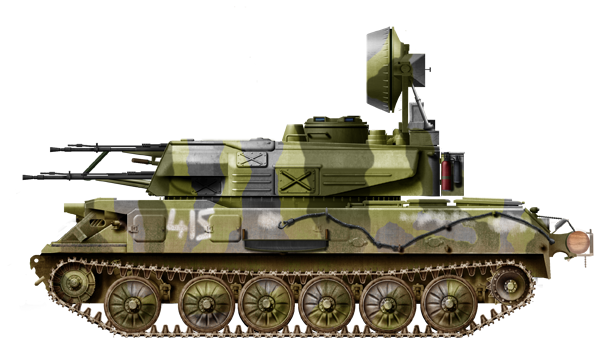
Another Syrian Model 72
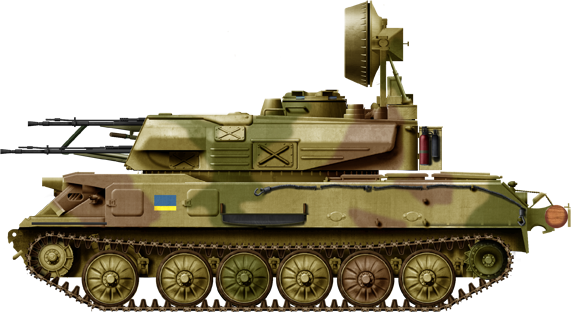
Egyptian Vehicle, Yom Kippur war 1973
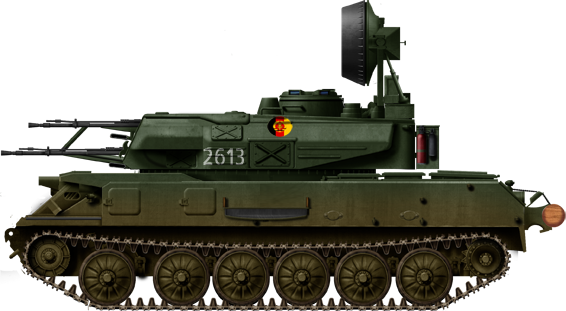
East German vehicle, Landstreitskräfte, tactical number 2613
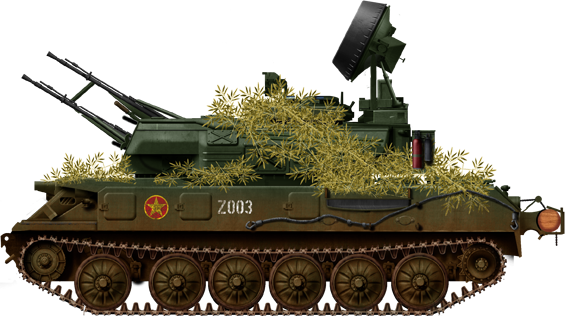
Shilka NVA, Vietnam
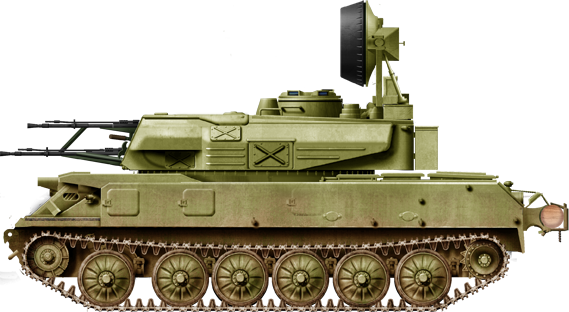
Iraqi Vehicle, 1990
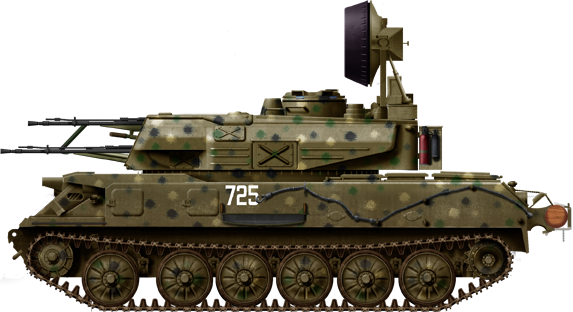
Vehicle from Azerbaidjan.
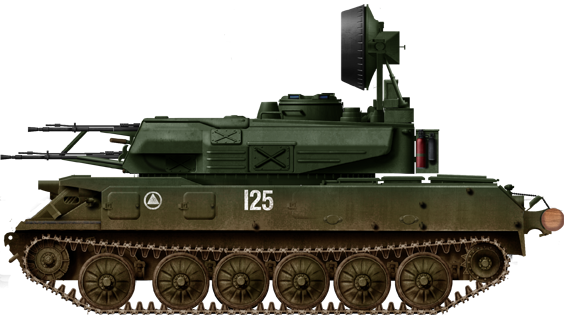
Shilka of the 503st Regiment, Grozny 1995
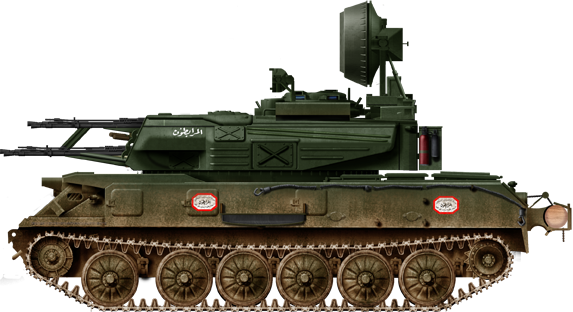
4M from Al Murabitum, Lebanon 1988
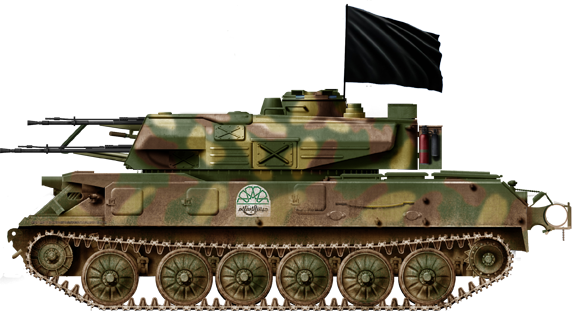
Jaysh Al Islam, islamic Front, Syrian Civil War 2010s
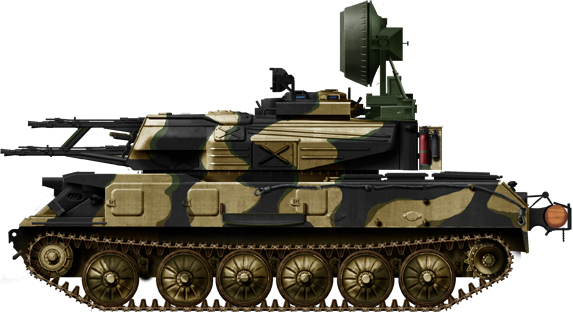
4M used by the libyan Pro-Government Forces 2011
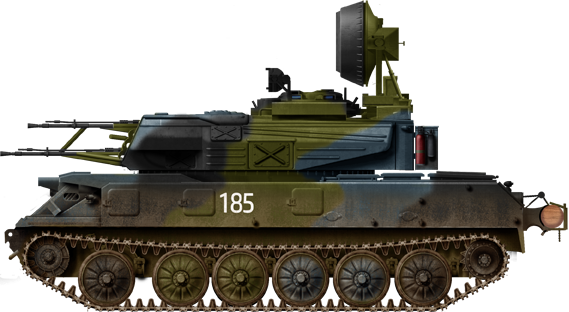
4M2 105th Mot. Rifle Rgt. Ural District 1998
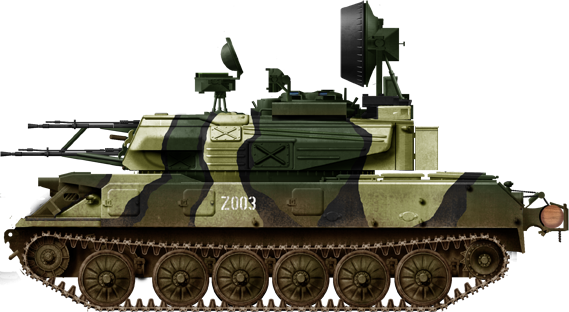
ZSU-23-4M2 of Russian Marines, Black Sea Fleet, 2011
Gallery
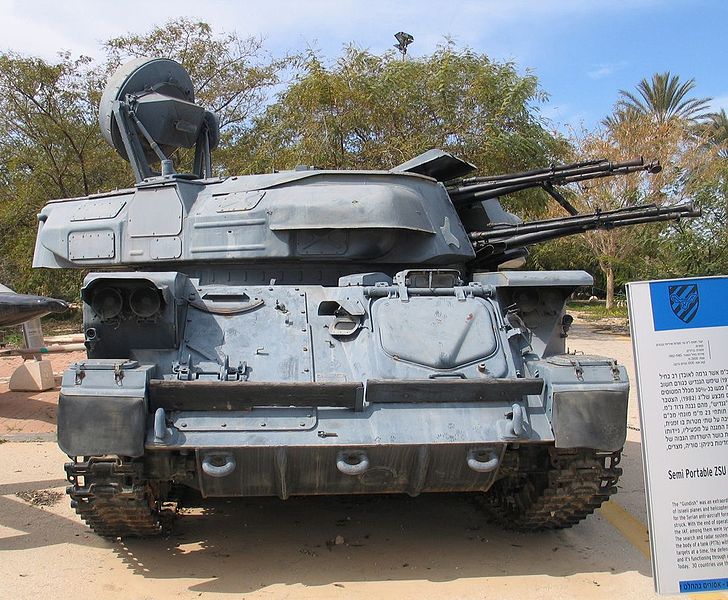
ZU-23-4-Shilka-hatzerim.
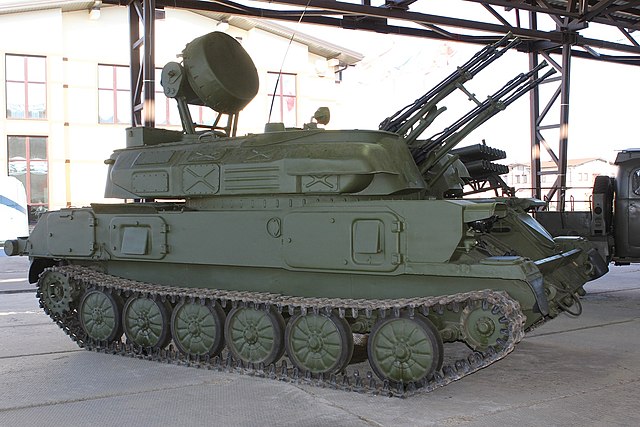
ZSU-23-4_shilka_museum.
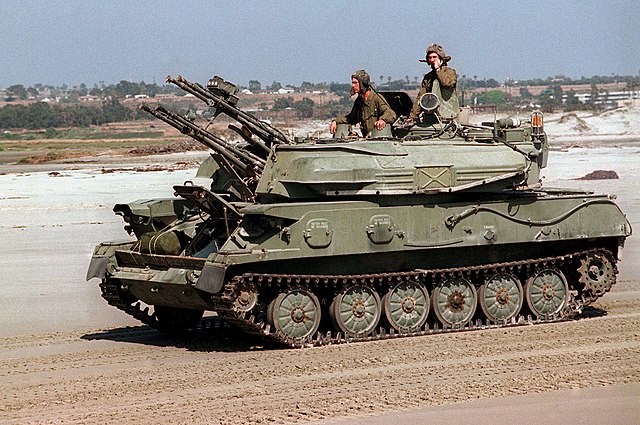
ZSU-23-4-Camp-Pendleton
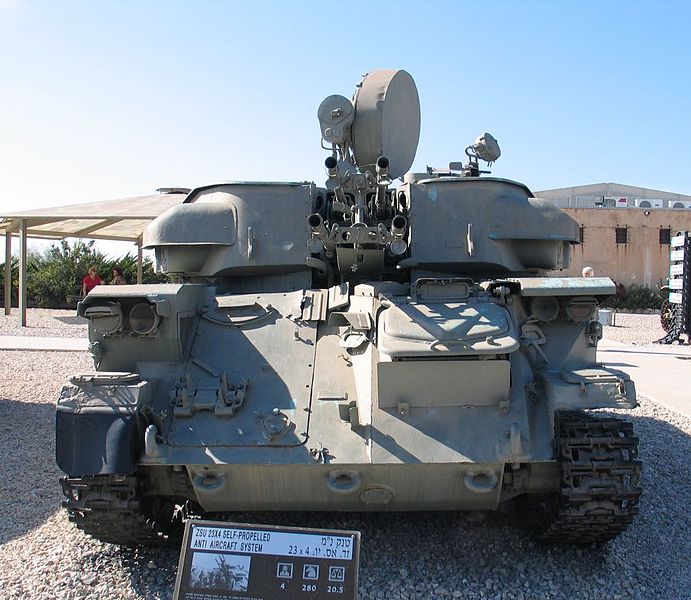
ZSU-23-4-latrun-1
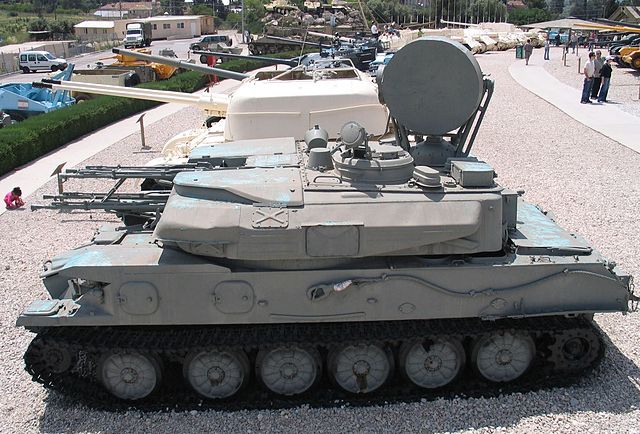
ZSU-23-4-latrun-4
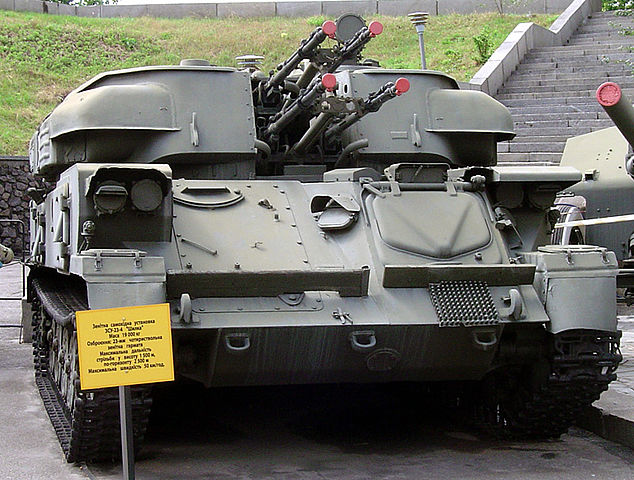
Zsu-23-4_shilka
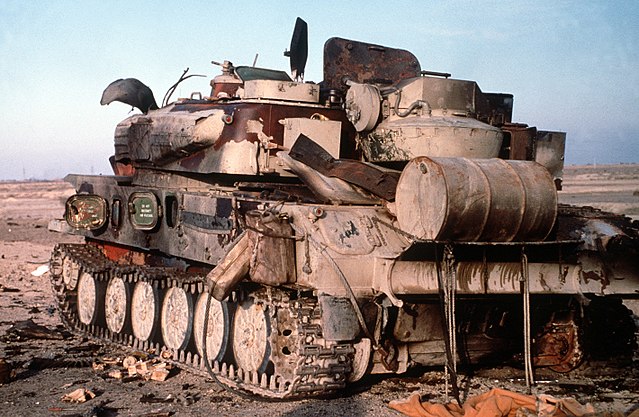
Destroyed_ZSU-23-4
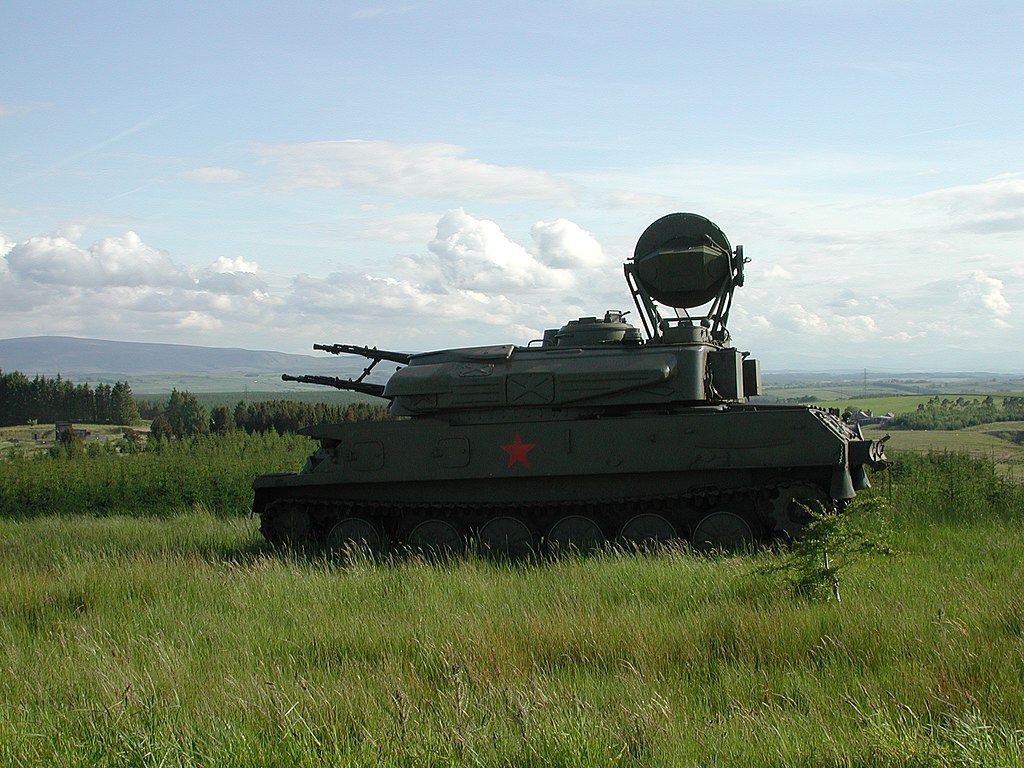
Zsu-26-4-scotland.
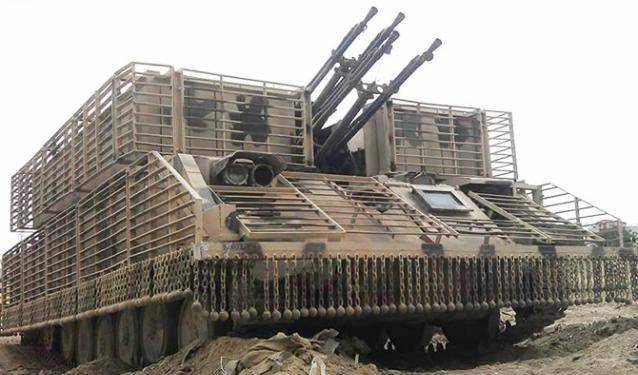
syrianCvwar-Shilka-uparmored

Cold War Tanks


































Cold war tanks posters

Cold War Main Battle Tanks

Cold War Soviet Army

